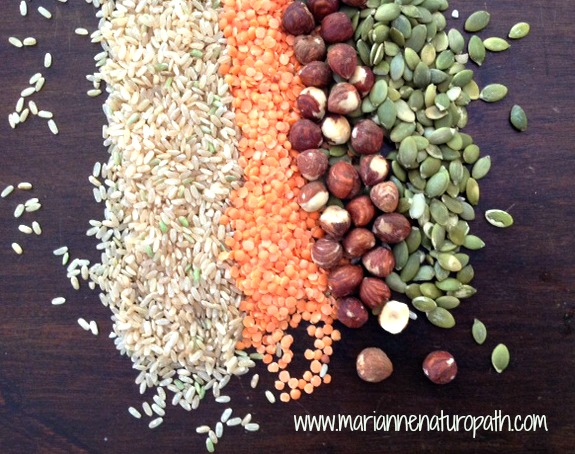Why You Should Soak Your Grains, Legumes, Nuts & Seeds
Raw grains, legumes, nuts and seeds all contain a substance called phytate (in varying quantities) which interferes with our digestion’s ability to absorb nutrients. They also have a protein called lectin which is found in the seed of a plant and are resistant to human digestion. Soaking of grains, legumes, nuts and seeds is a method of food preparation that is used in traditional cultures, but which is not widely used these days in more ‘developed’ countries. It is a method of food preparation that is important for us to use when preparing these foods because when they are soaked in filtered water with an acid medium they become easier to digest and this then improves absorption of nutrients.
Why?
Phytates:
Grains, legumes, nuts and seeds contain anti-nutrients called phytates and phytic acid, that block the absorption of key minerals. Phytic acid acts like a storage container which holds potassium, magnesium, calcium, zinc and iron. Phytates bind to these minerals like a glue which keeps them in the container. As the minerals become bound, mineral deficiencies can result.
This leads to:
- decreased bone density
- poor teeth & skin health
- reduced immunity
- stress on the digestive system.
While cooking grain, legumes, nuts and seeds does break down phytates to a degree, but it’s not enough to prevent them from influencing mineral levels. This is why soaking is an important step in their preparation (others methods are sprouting and souring). When these foods are soaked before cooking, an enzyme called phytase is released. Phytase breaks down the phytic acid content of the grain, legume or nut so that the minerals become available and easier to absorb.
Phytase is also found in raw plant foods but often we don’t eat enough of these foods to provide enough of it to break down grains, legumes and nuts we eat. In addition, the more grains are processed such as for flours, rolled oats and other grains, the more levels of phytase are reduced. According to Sue Becker phytates are necessary to bind ‘toxic substances and carry them out of our bodies’ (www.info.breadbeckers.com/phytic-acid). However, soaking only reduces 10% of phytates and so they will still be contained, although in lesser amounts, in these foods when consumed.
Lectins:
Lectins are not broken down in the human digestive tract and can damage the intestinal lining as they move through. In addition they slow down the process of gut repair and contribute to ‘leaky gut’ – a condition where large molecules not wanted by the body are able to move through the gut wall into the blood stream which sets up toxicity and inflammation. Leaky gut also reduces the body’s ability to absorb essential micronutrients.
Method of Soaking:
The method is simple but needs some planning in advance:
- Place your grain, legumes or nuts in a bowl and add enough warm filtered water to cover it.
- Then add your chosen acid medium (about one teaspoon of acid to one cup of water).
- You can choose from both dairy and dairy-free mediums. Dairy options include whey, cultured buttermilk, raw yoghurt or kefir. Non-dairy options include lemon juice, non-dairy kefir, water, coconut water, or unpasteurized apple cider vinegar.
- The general rule of thumb is to include one teaspoon of acid medium per cup of grain.
- Once the acid is added, cover the bowl and soak between 8-24 hours.
- When you are ready to cook, rinse the grain thoroughly, and cook as you would normally.
This practice can be used for all grains such as oats, rice, wheat, farro, buckwheat, millet, spelt, amaranth, legumes, nuts and seeds. In her book “Nourishing Traditions, Sally Fallon states that whole rice and unhulled millet contain less phytates and do not always need soaking, and flaxseeds don’t need soaking if eaten in small amounts. Quinoa should be soaked for up to 12 hours or at least overnight.
Legumes and beans will require longer soaking – a minimum of 24 hours and up to 48 hours. With longer soaking periods, fermentation will occur and it is important to rinse the legumes or beans and change the soaking water. It is not necessary to eliminate all phytates and lectins from our food but to keep them at reasonable levels.
Nuts & seeds need to be soaked overnight.
Soaking these foods is similar to the process of fermentation and sprouting foods before eating.
Another school of thought is against soaking due as it is considered that phytates are necessary for health and that lectins support immune function. However I am a proponent of this method of food preparation as levels of both phytate and lectins remains and I have seen the improvements in the digestive health of clients with gut issues who have begun the practice of soaking.
Marianne Harold
February 2015
References:
- “Nourishing Traditions”, Sally Fallon, New Trends Publishing 1999
- www.westonaprice.org/health-topics/living-with-phytic-acidEgli, I et al, “The Influence of Soaking and Germination on the Phytase Activity and Phytic Acid Content of Grains and Seeds Potentially Useful for Complementary Feeding’, 2002, Journal of Food Science
- ‘Phytic Acid – Friend or Foe”, www.info.breadbreckers.com
Mendoza C et al “Effect of genetically modified, low-phytic acid maize on absorption of iron from tortillas’, Am J Clin Nut 1999 [abstract]

